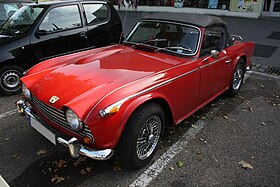Triumph TR250
| Triumph TR5 Triumph TR250 |
|
|---|---|
 |
|
| Overview | |
| Manufacturer | Triumph Motor Company |
| Production | 1967–1968 |
| Assembly | Coventry, England |
| Designer | Giovanni Michelotti |
| Body and chassis | |
| Class | Sports car |
| Body style | Roadster |
| Layout | Front-engine, rear-wheel-drive |
| Powertrain | |
| Engine | 2.5-litre straight-6 |
| Transmission | 4-speed manual, optional overdrive |
| Dimensions | |
| Wheelbase | 2,240 mm (88 in) |
| Length | 3,902 mm (154 in) |
| Width | 1,470 mm (58 in) |
| Height | 1,170 mm (46 in) |
| Kerb weight | 1,030 kg (2,271 lb) |
| Chronology | |
| Predecessor | Triumph TR4A |
| Successor | Triumph TR6 |
The Triumph TR5 is a sports car built by the Triumph Motor Company in Coventry, England, between August 1967 and September 1968.
Visually similar to the TR4 (also styled by Michelotti), the TR5 roadster sported Triumph's much more powerful 2.5-litre straight-6, fitted with Lucas mechanical fuel-injection and producing 145 bhp (108 kW). Price pressures and tighter emissions standards in the U.S. resulted in a much less powerful carburetted version, the TR250, being sold on the North American market.
At the time, fuel injection was uncommon in road cars. Triumph claimed in their sales brochure that it was the "First British production sports car with petrol injection".
Standard equipment included front disc brakes, independent rear suspension, rack and pinion steering and a four speed gearbox. Optional extras included overdrive and wire wheels. In 1968 the basic price of the TR5 in the UK was £1,260 including taxes, with wire wheels being another £38, overdrive £60 and a tonneau cover another £13.
The TR5 was available with the "Surrey Top" hard top, a weather protection system with rigid rear section including the rear window and removable fabric section over the driver and passenger's heads.
Taken from the UK sales brochure.
The fuel-injected engine could propel the TR5 from 0–50 mph (80 km/h) in just 6.5 seconds, reaching a top speed of 125 mph (201 km/h). Road tests at the time reported slightly different performance figures:
The TR5 engine was carried forward to the TR6.
The TR5 was produced in small numbers when compared with the later TR6, with just 2,947 units produced; the first car was assembled on 29 August 1967 and the last on 19 September 1968. Of these, 1,161 were destined for the UK market, the remainder being LHD TR5s and going to France, Belgium and Germany amongst others. In the first quarter of 2011 there were approximately 410 licensed and 74 SORN TR5s registered with the DVLA.
...
Wikipedia
